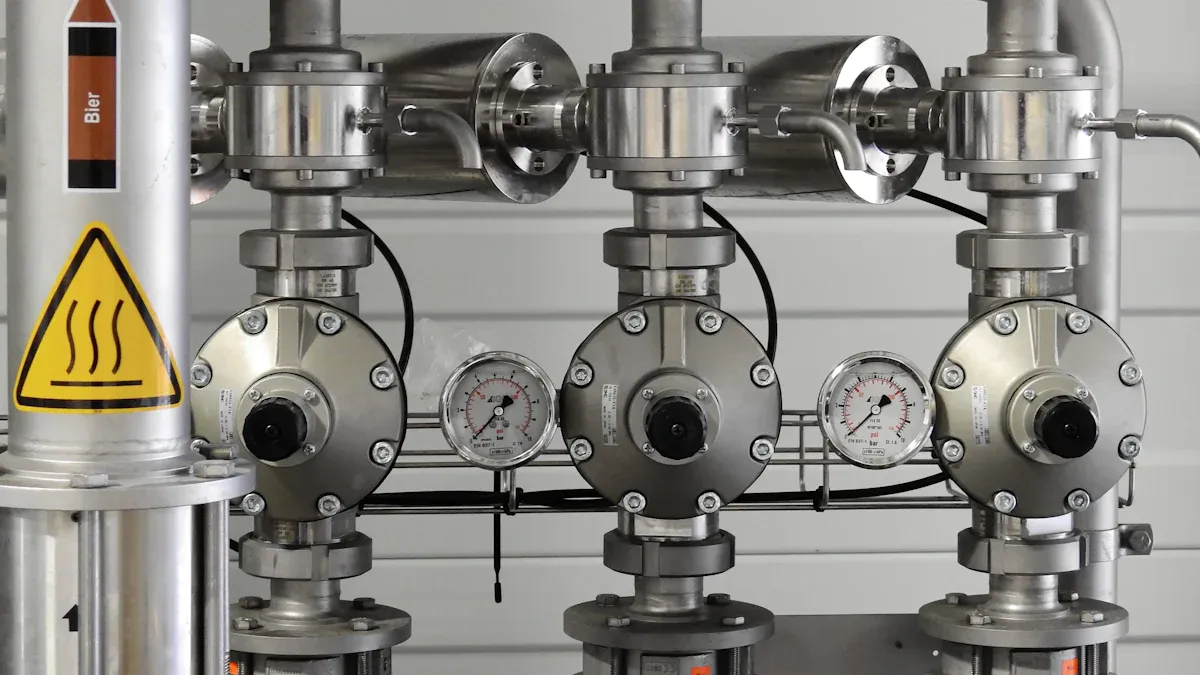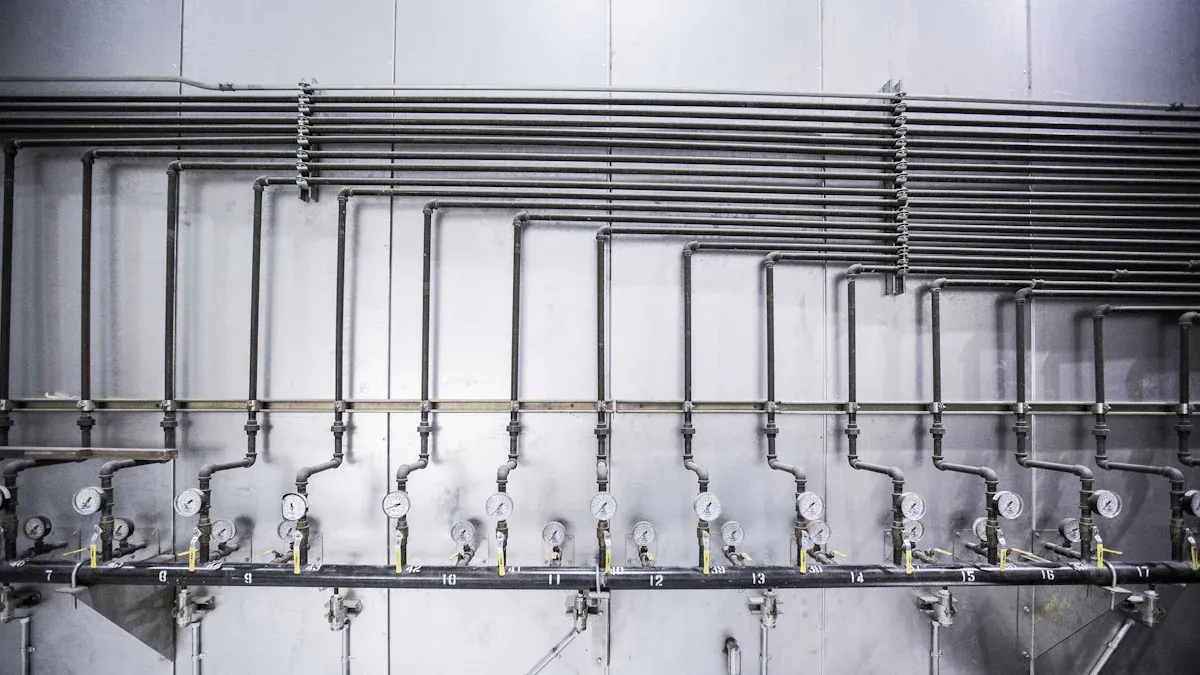
Stainless steel fittings are essential in plumbing systems due to their unmatched durability. They resist corrosion, thanks to a protective oxide layer, making them perfect for humid or chemically exposed environments. Their versatility shines through in various applications, including the use of hose coupling and Parker hydraulic fittings, which are ideal for both residential and industrial plumbing. Additionally, the installation of hydraulic fittings is a breeze, saving both time and labor costs. When you consider the long-term savings they offer, investing in stainless steel fittings is a smart choice for any plumbing project.
Key Takeaways
- Stainless steel fittings offer unmatched durability, lasting between 70 to 100 years, making them a reliable choice for plumbing systems.
- Their exceptional corrosion resistance makes them ideal for harsh environments, such as marine and chemical settings, ensuring long-term performance.
- Stainless steel fittings are easy to install, saving up to 60% in installation time compared to traditional methods, which reduces labor costs.
- Investing in stainless steel fittings may have higher initial costs, but their low maintenance needs and longevity lead to significant long-term savings.
- These fittings are versatile and safe for various applications, including residential, commercial, and industrial plumbing, ensuring peace of mind for users.
Durability of Stainless Steel Fittings

Long-lasting Performance
Stainless steel fittings stand out for their impressive longevity. Under normal operating conditions, these fittings can last between 70 to 100 years. For instance, Grade 304 stainless steel fittings typically endure for about 70 to 100 years, while Grade 316 fittings can exceed 100 years with proper care. This remarkable lifespan makes them a reliable choice for any plumbing system.
When comparing stainless steel to other materials, the differences become clear. Here’s how they stack up:
- Corrosion Resistance: Stainless steel fittings resist corrosion better than brass or PVC, making them ideal for harsh environments.
- Strength: They are stronger than brass, which is crucial for high-pressure applications.
- Temperature Resistance: Stainless steel can handle extreme temperatures, making it versatile for various settings.
- Hygienic: These fittings are easy to clean and do not harbor bacteria, which is essential for food and medical applications.
In contrast, brass fittings, while decent, do not perform as well in aggressive water conditions. PVC fittings may be affordable and easy to install, but they lack the durability and pressure resistance that stainless steel offers.
Impact Resistance
Impact resistance is another critical factor in the durability of stainless steel fittings. They undergo rigorous testing to ensure they can withstand harsh conditions. Industry standards, such as those set by ASTM, provide guidelines for measuring this resistance. Here’s a quick look at some relevant ASTM standards:
| ASTM Standard | Description | Key Specifications |
|---|---|---|
| ASTM A182 | Forged fittings for high-temperature service | Tensile strength: ≥485 MPa, Hardness: ≤192 HB, Corrosion testing per ASTM G48 |
| ASTM A403 | Welded fittings for austenitic stainless steel | Hydrostatic testing at 1.5x design pressure |
| ASTM A815 | Specialty alloys including duplex and super duplex | Critical for offshore and chemical processing applications |
These standards ensure that stainless steel fittings can handle the demands of both residential and industrial plumbing systems. Their ability to resist impact and maintain integrity over time makes them a top choice for anyone looking to invest in a reliable plumbing solution.
Corrosion Resistance of Stainless Steel Fittings

Stainless steel fittings excel in environments where corrosion is a major concern. Their unique properties make them ideal for harsh conditions, such as those found in marine and chemical industries.
Ideal for Harsh Environments
In marine settings, stainless steel fittings, especially those made from 316L grade, withstand exposure to saltwater and extreme weather. These fittings resist corrosion from chlorides and salt, which can quickly damage other materials. For example, 316 stainless steel fittings show impressive performance in hot, concentrated seawater. Studies reveal that they can endure up to 6800 hours of immersion with only minor pitting. This durability is crucial for maintaining the integrity of plumbing systems in challenging environments.
Here are some key points about stainless steel fittings in harsh conditions:
- Exceptional Resistance: 316 stainless steel is preferred in marine applications due to its superior corrosion resistance.
- Chemical Resilience: These fittings can handle various chemicals, making them suitable for chemical processing and food safety.
- Longevity: The ability to resist corrosion extends the service life of plumbing systems, reducing the need for frequent replacements.
Comparison with Other Materials
When comparing stainless steel fittings to other materials, the differences in corrosion resistance become clear. For instance, galvanized steel relies on a zinc coating for protection. However, this layer can fail in salty environments, leading to rapid corrosion. In contrast, stainless steel forms a protective layer of chromium oxide that shields it from rust and corrosion.
Here’s a quick comparison of corrosion resistance among common materials:
| Material | Corrosion Resistance in Harsh Environments |
|---|---|
| Stainless Steel | Excellent, especially 316L |
| Galvanized Steel | Moderate, vulnerable to saltwater |
| Brass | Limited, can suffer from dezincification |
| Plastic | No corrosion issues |
Stainless steel fittings outperform brass and copper in many scenarios. While copper fittings resist corrosion well, they can corrode when paired with stainless steel due to galvanic corrosion. This occurs when two different metals come into contact, causing the less noble metal to corrode faster.
Versatility in Applications of Stainless Steel Fittings
Stainless steel fittings shine in various plumbing applications, making them a go-to choice for many projects. Their adaptability allows them to meet the unique demands of different environments.
Residential Plumbing
In residential settings, homeowners and contractors appreciate the benefits of stainless steel fittings. Here are some key advantages:
- Corrosion Resistance: These fittings resist corrosion in various environments, including pure water and acidic conditions.
- Durability: They boast a lifespan of over 50 years, making them more durable than other materials.
- Low Maintenance: Stainless steel systems require minimal upkeep, reducing long-term costs for homeowners.
- Hygienic & Safe: They do not contaminate drinking water, ensuring safety for families.
- Aesthetic Appeal: Stainless steel enhances the visual appeal of plumbing fixtures in homes.
| Benefit | Description |
|---|---|
| Corrosion Resistance | Stainless steel fittings resist corrosion in various environments, including pure water and acidic conditions. |
| Durability | They have a lifespan of over 50 years, making them more durable than other materials. |
| Low Maintenance | Stainless steel systems require minimal maintenance, reducing long-term costs for homeowners. |
| Hygienic & Safe | They do not contaminate drinking water and are safe for use. |
| Aesthetic Appeal | Stainless steel enhances the visual appeal of plumbing fixtures in homes. |
Commercial Plumbing
In commercial plumbing, stainless steel fittings are often specified for several reasons:
- Durability and Longevity: They resist corrosion and extreme temperatures, ensuring a long service life.
- Leak-Proof Connections: The fittings create tight seals, minimizing the risk of leaks.
- Easy and Quick Installation: No welding is required, allowing for faster installation.
- Cost-Effective in the Long Run: Low maintenance and reduced downtime contribute to overall cost savings.
- Hygiene and Safety: Non-reactive material is ideal for food and pharmaceutical applications.
Industrial Uses
Industries frequently rely on stainless steel fittings for their plumbing needs. Here are some key sectors:
| Industry | Key Applications |
|---|---|
| Chemical Processing | Connecting reaction vessels, joining pipes in distillation columns, fitting pumps and valves to main pipelines. |
| Food and Beverage | Dairy processing equipment, beverage bottling lines, commercial kitchen plumbing. |
| Oil and Gas | Connecting pipelines on oil drilling platforms, fitting valves in gas processing plants, joining pipes in refinery cooling systems. |
| Pharmaceutical Manufacturing | Sterile water systems, fermentation tank connections, vaccine production lines. |
| Power Generation | Steam turbine piping systems, cooling water circuits, fuel delivery systems in solar thermal plants. |
Stainless steel fittings are favored in these applications due to their ability to withstand high pressure and maintain hygiene standards. They ensure a seamless flow of products while adhering to safety regulations.
Ease of Installation of Stainless Steel Fittings
Compatibility with Existing Systems
Stainless steel fittings integrate seamlessly with various plumbing systems, even those made from different materials. This compatibility is crucial for both residential and commercial projects. Here’s how they benefit different application areas:
| Application Area | Benefits of Stainless Steel Fittings | Examples of Use |
|---|---|---|
| Residential Plumbing | Corrosion resistance ensures water purity, reducing contamination risk. | High-end residential developments in North America prefer stainless steel for longevity and low maintenance. |
| Commercial Plumbing | Withstands frequent use and high water flow rates without degrading. | Hospitals utilize stainless steel for sterile water delivery, leading to fewer system failures. |
| Infrastructure Projects | Essential for modern infrastructure due to durability and ease of maintenance. | Used in large industrial projects, transforming plumbing system design and maintenance. |
However, mixing stainless steel with other materials can pose some challenges. For instance, galvanic corrosion can occur when brass fittings come into contact with stainless steel. This happens because brass degrades faster in such situations. Additionally, certain chemicals in fluids can compromise the protective layers of both materials, leading to corrosion. Environmental factors like humidity and pollutants can also accelerate these processes, especially in coastal areas.
Time-Saving Benefits
When it comes to installation, stainless steel fittings shine. They can significantly reduce installation time compared to traditional methods. Here are some key points:
- Fast installation can cut down installation time by up to 60% compared to conventional fittings.
- Using press fittings can save even more time, reducing installation time by 50% to 90% compared to welding.
These time savings translate into lower labor costs. For example, contractors report that using stainless steel fittings can lead to labor cost savings of around 20%. Mike Wells, a project superintendent, noted, “The stainless has been nice from a cost savings standpoint.” Todd Elliot, a project executive, added, “Being able to use the same tool to press both stainless steel and copper fittings was a huge benefit.”
Overall, the ease of installation and compatibility with existing systems make stainless steel fittings a smart choice for any plumbing project.
Cost-Effectiveness of Stainless Steel Fittings
Long-term Investment
Investing in stainless steel fittings may seem costly at first, but it pays off in the long run. Here’s why:
- Higher Initial Costs: Stainless steel fittings typically have higher upfront costs compared to materials like brass. However, this initial investment is justified by their durability and low maintenance needs.
- Significant Long-term Savings: Over time, the savings from reduced maintenance and replacement costs can be substantial. For example, stainless steel fittings last longer and require fewer repairs, making them a cost-effective choice for plumbing systems.
- Durability Justifies Investment: In applications where durability is crucial, stainless steel fittings prove their worth. They withstand harsh conditions, reducing the need for frequent replacements.
Maintenance Savings
When it comes to maintenance, stainless steel fittings shine. They require minimal upkeep, which translates to lower costs over time. Here are some key points:
- Low Maintenance Needs: Unlike other materials, stainless steel fittings don’t need additional coatings or treatments. Their lifespan often exceeds 50 years, significantly cutting down on system downtime and maintenance costs.
- Comparison with Other Materials: A quick look at maintenance costs reveals the advantages of stainless steel:
| Material | Maintenance Costs | Durability |
|---|---|---|
| Stainless Steel | Low | Lasts for decades |
| Brass | Higher | Requires frequent maintenance |
- Lifecycle Cost Efficiency: While the initial investment in stainless steel fittings is higher, the overall lifecycle costs are lower. This is due to reduced repair and replacement needs, making them a smart choice for any plumbing project.
Stainless steel fittings play a vital role in maintaining plumbing system integrity. Their corrosion resistance ensures that both 304 and 316 stainless steel withstand rust and staining, which is crucial for long-lasting performance. In fact, 316 stainless steel is particularly suited for marine applications due to its enhanced resistance to chloride corrosion.
Investing in stainless steel fittings proves wise, as their benefits far outweigh initial costs. For example, these fittings often last 20 to 50 years, with many exceeding that lifespan in well-maintained environments. This reliability makes them a smart choice for any plumbing project.
Ultimately, choosing stainless steel fittings guarantees both reliability and longevity in plumbing systems, ensuring peace of mind for homeowners and professionals alike.
FAQ
What are the main benefits of using stainless steel fittings in plumbing?
Stainless steel fittings offer durability, corrosion resistance, and versatility. They last longer than other materials, require less maintenance, and are safe for drinking water. Their ability to withstand extreme conditions makes them ideal for various plumbing applications.
How do stainless steel fittings compare to plastic fittings?
Stainless steel fittings outperform plastic fittings in strength and durability. They resist high temperatures and pressures better than plastic. While plastic may be cheaper, it often lacks the longevity and reliability that stainless steel provides.
Can stainless steel fittings be used in outdoor plumbing?
Absolutely! Stainless steel fittings are perfect for outdoor plumbing. Their corrosion resistance protects them from harsh weather conditions, including rain and humidity. This makes them a reliable choice for outdoor installations.
Are stainless steel fittings easy to install?
Yes, stainless steel fittings are designed for easy installation. They often require no welding, which saves time and labor costs. Many contractors find them quicker to install compared to traditional fittings.
How do I maintain stainless steel fittings?
Maintaining stainless steel fittings is simple. Regularly inspect for leaks and clean them with mild soap and water. Avoid harsh chemicals that can damage the surface. Proper care ensures their longevity and performance.
Post time: Oct-09-2025
